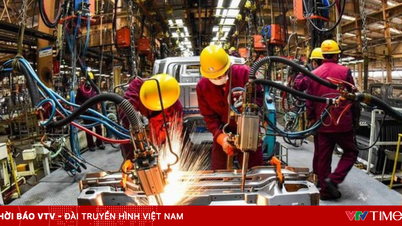According to the Global Times, China's gross domestic product (GDP) in the first quarter of this year reached 29.63 trillion yuan, up 5.3% year-on-year. China's manufacturing Purchasing Managers' Index (PMI) returned to growth in March, while the services PMI hit its highest point since July 2023.
 |
| Artists perform dragon dance in Shanghai, China. Photo source: Raul Ariano, Bloomberg |
China’s economy is also showing other encouraging signs. From January to March, the country’s fixed asset investment increased 4.5% year-on-year, up more than 1.5% from the previous year. In the first quarter, retail sales of consumer goods also increased 4.7% year-on-year, and online retail sales increased 12.4%.
Despite recent difficulties, foreign investors remain confident in the Chinese market. According to the Global Times, China has mobilized more than 100 billion yuan in foreign investment in the first quarter of this year. International financial institutions such as Goldman Sachs and Citi Group have both raised their forecasts for China's economic growth in 2024.
Where does China's economic recovery come from?
According to the Global Times, China's economic recovery comes from policies to adjust and upgrade the economic structure as well as transition to new growth drivers. Specifically, the three main factors that have contributed to China's economic recovery include increased investment in high-tech industries and the private sector, as well as changes in consumer habits.
At the heart of China’s economic recovery is the government’s push to invest in high-tech industries such as artificial intelligence (AI) and 5G. In the first quarter, investment in high-tech industries increased by 11.4% year-on-year, with investment in aerospace manufacturing and computer and office equipment manufacturing increasing by 42.7% and 11.8%, respectively. As a result, these high-tech industries not only contribute to the transformation of traditional industries, but also lay the foundation for the development of new industries in the future.
Rising per capita incomes have also played a role in boosting consumption growth and improving the economic structure. In the first quarter, per capita income in China increased by 6.2% year-on-year, even faster than GDP growth. With this increase in income, Chinese consumers are gradually changing their consumption habits, from choosing low-cost, mass-produced goods to more personalized and high-quality products.
The Chinese government is also creating conditions for the development of private sector investment. In the first two months of 2024, private investment accounted for 52.6% of the total national investment, up 2.2% over the same period in 2023. Experts believe that implementing policies to support the private economy will lay the foundation for promoting China's modernization and high-quality economic development.
Difficulties remain for the Chinese economy
“Despite a favorable start in the first quarter, China is still facing a number of difficulties and challenges,” said experts from the Global Times. These difficulties include low public expectations and an increasingly complex and unstable political situation in the world. However, experts are still optimistic about the stable, long-term growth of the Chinese economy in the coming time.
Shuli Ren, a financial analyst at Bloomberg, is more pessimistic about the future of China's economy. While high-tech exports, especially electric vehicles, are a major driver of China's economy, the future of the industry remains a question mark, according to Shuli Ren. Amid rising trade tensions and protectionism, politicians like German Chancellor Olaf Scholz and US Treasury Secretary Janet Yellen are expressing concerns about the industry's huge output.
In addition, according to Shuli Ren, the Chinese government is prioritizing the added value of each industry without taking into account the demand of buyers. According to data from Bloomberg, inventories in China increased 6.8% in February this year compared to the same period last year. In the future, if companies focus on selling inventory products before producing more, this will put pressure on China's GDP.
However, Ms. Shuli Ren also said that in the context of the Chinese economy undergoing structural changes, determining whether the country's economy is growing or declining is increasingly difficult. She also advised analysts to research and review small data, and to be skeptical of allegations of fabricating or falsifying statistics.
Source



![[Photo] Solemn opening of the 1st Government Party Congress](https://vphoto.vietnam.vn/thumb/1200x675/vietnam/resource/IMAGE/2025/10/13/1760337945186_ndo_br_img-0787-jpg.webp)


































![[Photo] General Secretary To Lam attends the opening of the 1st Government Party Congress](https://vphoto.vietnam.vn/thumb/1200x675/vietnam/resource/IMAGE/2025/10/13/1760321055249_ndo_br_cover-9284-jpg.webp)









































































Comment (0)